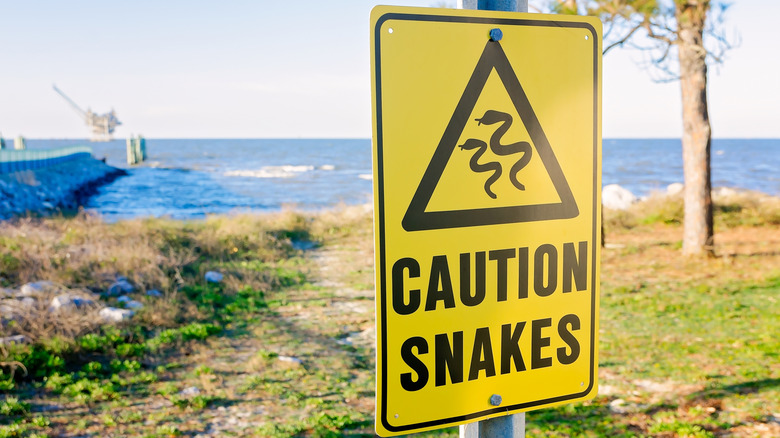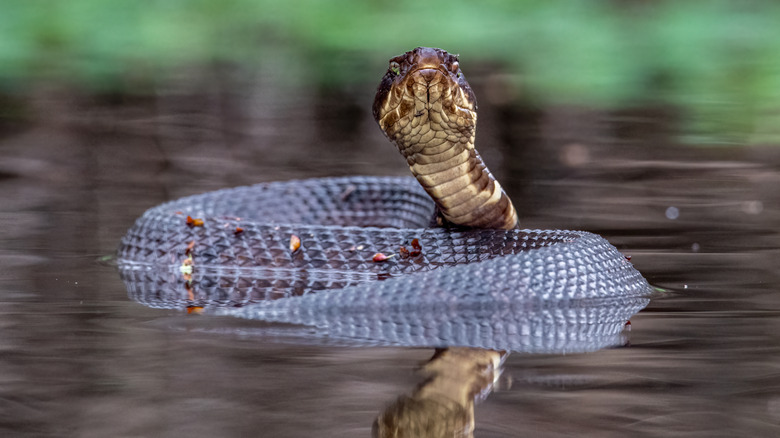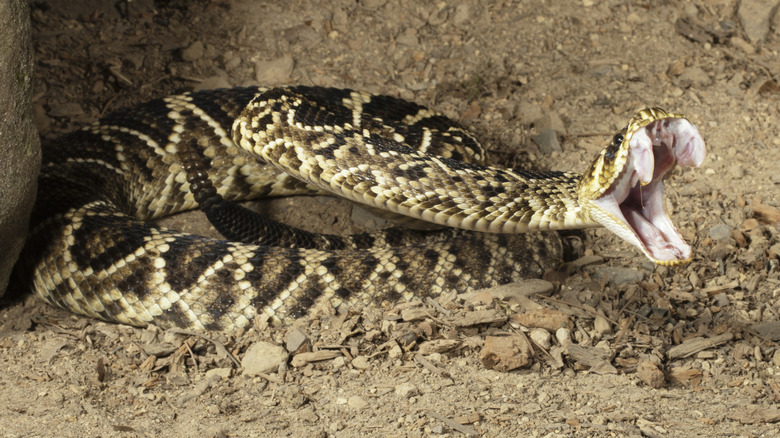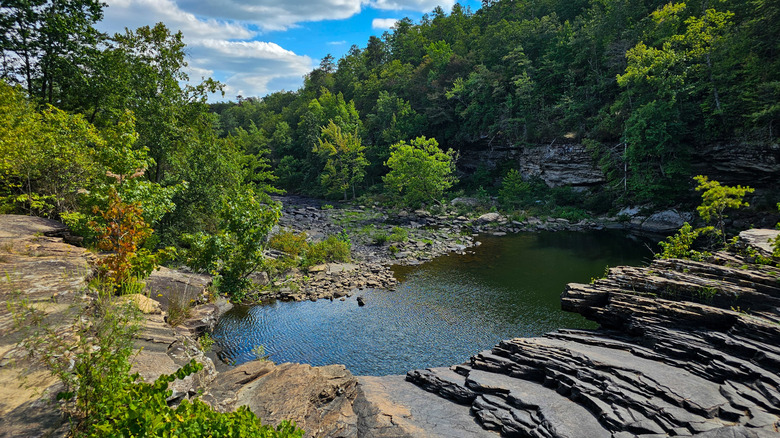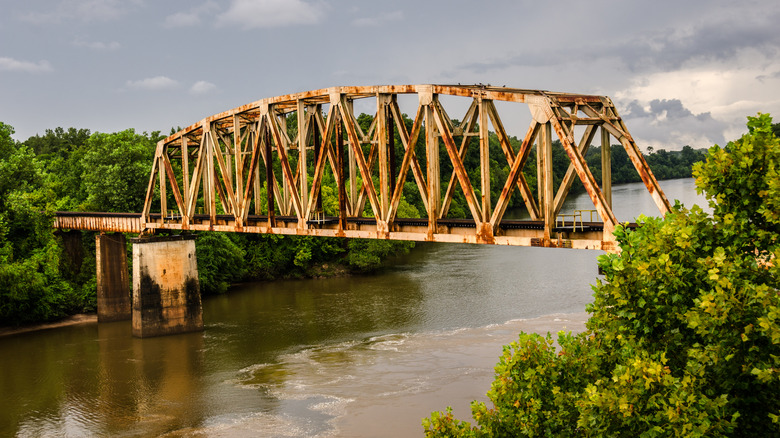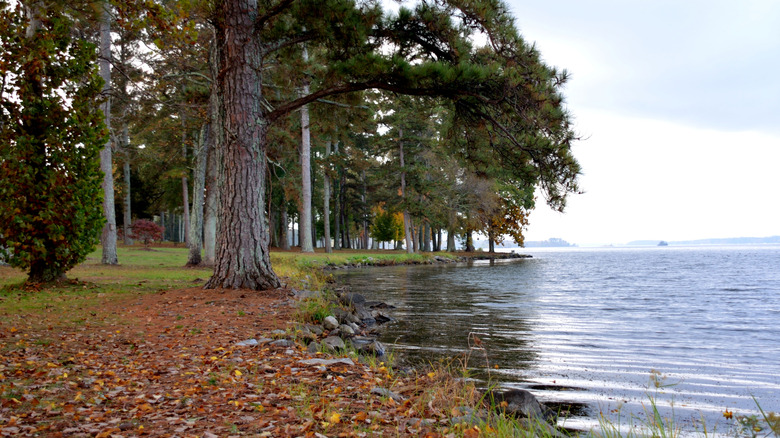These Snake-Filled Alabama Waters Aren't For The Faint Of Heart (Here's What To Know Before Diving In)
The great state of Alabama isn't known for any one thing — from Southern hospitality to food and music culture, this place has something for everyone. Bordered on the east by Georgia and the west by Mississippi, it also touches Tennessee to the north, and Florida, including a small piece of coastline, to the south. In fact, Alabama's seafood capital is a sleepy, wildly underrated town on the gorgeous gulf coast, and it's not to be missed. In addition to some city hubs like Huntsville and Birmingham, the state is teeming with stretches of natural land and wildlife. From lakes and rivers to the Gulf Coast, there are plenty of opportunities to get out on the water, but first you should be aware of Alabama's prevalence of snakes.
Alabama is home to over 60 species and subspecies of snakes, 11 of which are poisonous to humans. While there may be some that are technically venomous among the rest of the bunch, they only pose a threat to other wildlife. There are all different types of measures you can take to protect yourself from a snake bite on land, and paying attention to your surroundings is key. Snakes are trying to avoid you just as much as you want to avoid them, so keeping a vigilant watch for these animals when you're traversing their habitat is wise.
One place it can be more difficult to avoid contact with certain snakes is in the water, as they may blend into their surroundings in a way that makes spotting them more challenging. For example, the Alabama River is home to no less than 10 different species of snakes, including one that is particularly dangerous to humans — the Northern cottonmouth snake. Here's what you need to know about Alabama's most snake-infested bodies of water.
The Alabama and Mobile Rivers are home to a well-known venomous snake
You can expect to find snakes in the Mobile River that are similar to what slithers in the Alabama River, as they are part of the same river system. Common snakes found in both rivers include the midland water snake, the plain-bellied water snake, the diamond-backed water snake, the queen snake, the brown water snake, the banded water snake, the gulf salt marsh water snake, the Mississippi green water snake, the gulf swamp snake, and the northern cottonmouth snake, which happens to be the only one out of the bunch that's venomous to humans. Found exclusively in Southeastern states, you may know the cottonmouth by its more common nickname, the water moccasin.
So what does this mean for visitors to these rivers? The Alabama River is meandering enough to be a popular place for recreation like tubing, canoeing, and swimming, so if you choose to partake in these activities you should be aware that you may encounter any one of these snakes, including the cottonmouth. It's best to keep your eyes peeled and steer clear of these animals when possible, because if you don't bother them, they will more than likely not bother you. Cottonmouths are typically prone to bite only if they feel threatened, and their bite can kill within hours if the proper medical care and anti-venom is not administered.
As for the Mobile River, you may want to avoid these waters regardless of it's snake population, due to severe water pollution from industrial plants. In 2022, it was named the third most endangered river due to pollution in the country by American Rivers, and while cottonmouth snakes commonly take to these waters, venomous copperheads can be found along the shore as well.
Recreation on the Styx River can be dangerous
It may not come as a surprise that a river named after the River Styx from Greek mythology could hold some potentially deadly dangers, as the myth goes that this river created the border between the underworld and the world of the living. Today, the Styx River flows through Southern Alabama for about 40 miles, and has some of the best water for tubing, kayaking, canoeing, and fishing.
Visitors to the Styx River probably don't expect to have a near-death experience, but that's exactly what happened to a 23-year-old man in 2018 when he was bitten by a four-foot diamondback rattlesnake while tubing (via NBC15 News). Justin Clarke was reportedly life-flighted to Sacred Heart Hospital to receive anti-venom, which is well-stocked in emergency rooms in the area. "It's actually an infusion that's given over an hour and the physician will come back in and look at the sight and make sure the swelling has not extended past where we've marked a line, and if it is, you would actually have to get another dose," Sabrina Phillips, who worked in the ER Department at Thomas Hospital, told NBC15 News. Clarke reportedly required 14 doses of anti-venom to save his life.
The bite occurred while Clarke was allegedly attempting to kill the snake, which is inadvisable. Diamondback rattlesnakes are both large and dangerous, but they also prefer to avoid human interaction. "It's more our activity, and what we do that causes those interactions to increase. We're going to the river tubing, riding four-wheelers and we are in their habitat even more. That is going to increase those opportunities for us seeing snakes," Mike Casper, a reptile expert with the reptile education awareness group REACH, shared with NBC15 News.
How to avoid snake bites in Little River Canyon
Moving north, the Little River flows through the top part of Alabama, and the Little River Canyon National Reserve holds a big draw for visitors: the three waterfalls of DeSoto Falls, Little River Falls, and Grace's High Falls. With the natural beauty that's found in this area comes a variety of wildlife, including snakes. Three of such species are venomous, and those would be two of the snakes we've already covered, the cottonmouth and copperhead, as well as the timber rattlesnake. Caution is advised when it comes to swimming in this area as the Little River has strong currents, but there are some popular swimming holes where it's safe to jump in, including the Blue Hole, Eberhart Point, and Canyon Mouth Park.
The National Park Service has a list of guidelines that help visitors respect the wildlife, including some applicable to potential contact with snakes. Keeping all pets closely leashed, staying in designated areas and not leaving marked trails, footpaths, or roads, and paying close attention to where you step are all important things to keep in mind. Many species of snake will strike if they are stepped on or disturbed, so always watch your step, and never put your hands where you can't see them.
Snake incidents in Little River Canyon are rare, but they do occur. In 2003, a 15-year-old boy encountered a copperhead snake and attempted to move the snake with his bare foot, resulting in a bite he was successfully treated for, as reported by the National Park Service (NPS). This incident highlights the importance of following the NPS guidelines, which advise to allow a snake to cross a trail without attempting to walk near or step over it, as the snake could perceive this to be threat.
Three different venomous snakes swim in the Chattahoochee River
Given the sheer size of the Chattahoochee River (it spans over 430 miles), its suitability for swimming and other recreation can widely vary depending upon where you are. The river touches both Alabama and Georgia as part of the border between the two, and ends in the Florida city of Chattahoochee, from which it gets its name. Water quality, different current strengths, and natural hazards like submerged obstacles, sudden drop offs, and wildlife (like snakes) all come into play when determining when and where to enjoy this iconic river. The National Park Service manages the Chattahoochee River National Recreation Area (CRNRA), which features areas with signage committed to designating safe places to swim and wade. There are also a number of local parks that offer lifeguard patrol during peak seasons, some of which can be found in both Buford and Suwanee.
Once you've determined where you'll be diving into the Chattahoochee River, you should be aware that there could be no less than 11 species of snakes sharing the water with you to include the timber rattlesnake, the Northern water snake, the Southern copperhead, the brown water snake, the rainbow snake, the Eastern diamondback rattlesnake, the Southern water snake, the Southeastern crown snake, the copperhead snake, the plain-bellied water snake, and the Mississippi green water snake. Of all these species a handful are venomous, including the cottonmouth snake, the copperhead snake, the Eastern diamondback rattlesnake, and the timber rattlesnake.
In fact, although it's rare, one 31-year-old man lost his life in 2004 after being bitten by a copperhead snake (via WTVY). Trent Leprette was swimming in Saugahatchee Creek when he was bitten two times, and although treated, he succumbed to his wounds after he was determined to be allergic to snake venom.
Lake life in Alabama is sure to bring snake encounters
We've talked a lot about the rivers of Alabama, but the state also has many lakes that snakes call home, and these areas are even more popular for recreation like swimming, boating, kayaking, canoeing, and fishing.
Lay Lake is a 12,000-acre reservoir located south of the city of Birmingham, and with murky water and overgrowth running rampant in this area, it creates the perfect environment for snakes to thrive and stay. There are both venomous and non-venomous species, and sometimes it can be hard to tell the difference. For instance, the non-venomous midland water snake is very common and can easily be mistaken for a more dangerous species. The time of year also comes into play when determining snake activity, as increased boating from May through September tends to drive snakes towards the shoreline.
Those looking to take part in a fishing tournament may find themselves at the 69,000-acre Guntersville Lake, where it's not unusual to see venomous cottonmouth and copperhead snakes. Rat snakes and garter snakes also make common appearances, but this is not unexpected for those who are familiar with the area. Lake Martin is another popular recreational destination with 44,000 acres of water and over 750 miles of shoreline. Non-venomous water snakes are common here, and like the midland water snake, it's easy to mistake them more dangerous snakes like cottonmouths. Like in most Alabama waters, copperheads can also be found.
To learn more about snakes and where to find them during your travels, check out the most snake-infested lakes in Arizona that'll have you reconsidering your next swim and these iconic, wild, and beautiful West Virginia waters might also be the most snake-heavy.
